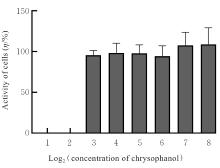| [1] |
Haoyu WANG,Yuqi WANG,Bingqian WANG,Jinhan NIE,Jiaqing YAN,Min HU.
Inhibitory effect of mesalazine on pro-inflammatory factors and peroxides in RAW264.7 cells and its therapeutic effect on periodontitis model rats
[J]. Journal of Jilin University(Medicine Edition), 2024, 50(5): 1250-1258.
|
| [2] |
Yuxiao SHI,Meilan LIU,Meilin ZHU,Feng WEI.
Effects of 5-Aza-CdR on autophagy and apoptosis of papillary thyroid cancer cells in subcutaneous xenograft tumor tissue of nude mice and its mechanism
[J]. Journal of Jilin University(Medicine Edition), 2024, 50(5): 1330-1338.
|
| [3] |
Fengmei XIONG,Yuxiang CAI,Zhuo LIU,Na SUN,Yang LI.
Alleviatory effect of curcumin on cardiomyocyte toxicity induced by doxorubicin by regulating SIRT3/SOD2 signaling pathway
[J]. Journal of Jilin University(Medicine Edition), 2024, 50(5): 1339-1347.
|
| [4] |
Yongjing YANG,Tianyang KE,Shixin LIU,Xue WANG,Dequan XU,Tingting LIU,Ling ZHAO.
Synergistic sensitization of apatinib mesylate and radiotherapy on hepatocarcinoma cells invitro
[J]. Journal of Jilin University(Medicine Edition), 2024, 50(4): 1009-1015.
|
| [5] |
Guoxing YU,Xin ZHANG,Hengwei DU,Bingjie CUI,Na GAO,Cuilan LIU,Jing DU.
Effect of urolithin C on proliferation, apoptosis and autophagy of human acute myeloid leukemia HL-60 cells and its mechanism
[J]. Journal of Jilin University(Medicine Edition), 2024, 50(4): 908-916.
|
| [6] |
Chao LIANG,Juanjuan DAI,Ning ZHOU,Dandan WANG,Jie ZHAO,Di AN,Yan WU.
Effect of oridonin on cell proliferation, migration, and apoptosis of human nasopharynx carcinoma HONE-1 cells
[J]. Journal of Jilin University(Medicine Edition), 2024, 50(4): 917-924.
|
| [7] |
Xueting CHI,Fangyuan CHEN,Zifeng PI,Guangfu LYU,Yuchen WANG,Yinqing LI,Xiaowei HUANG,Zhe LIN.
Improvement effect of velvet antler polypeptide on postmenopausal osteoporosis in rats and its mechanism
[J]. Journal of Jilin University(Medicine Edition), 2024, 50(4): 963-969.
|
| [8] |
Tengfei WANG, Feng CHEN, Ling QI, Ting LEI, Meihui SONG.
Inhibitory effect of D-limonene on proliferation of glioblastoma cells and its mechanism
[J]. Journal of Jilin University(Medicine Edition), 2024, 50(3): 647-657.
|
| [9] |
Jiacai FU,Lingsha QING,Lu YANG,Meihui SONG,Xianying ZHANG,Xiaocui LIU,Fengjin LI,Ling QI.
Inhibitory effect of Schisandrin B on proliferation of pancreatic cancer Pan02 cells and its mechanism
[J]. Journal of Jilin University(Medicine Edition), 2024, 50(3): 638-646.
|
| [10] |
Jianan HAN,Zhuorui LIU,Peiyong ZENG,Shuang JIANG,Hongyu LI.
Anti-fatigue effect of Wujia Shengmai Yin in mice and its mechanism
[J]. Journal of Jilin University(Medicine Edition), 2024, 50(3): 689-696.
|
| [11] |
Lin CHEN,Limin YAN,Huaijie XING,Min CHEN,Xiaoyan LI,Chaosheng ZENG.
Improvement effect of Xuebijing on brain tissue injury and Th17/Treg immune imbalance in cerebrospinal fluid in NMDA receptor encephalitis model mice
[J]. Journal of Jilin University(Medicine Edition), 2024, 50(3): 697-707.
|
| [12] |
Jing TANG,Huan LI,Shuo ZHANG,Ligang JING.
Analysis on association between serum homocysteine and inflammatory response and oxidative stress in patients with acute ischemic stroke
[J]. Journal of Jilin University(Medicine Edition), 2024, 50(3): 786-790.
|
| [13] |
Yingxin RUAN,Junya JIA,Zhanfei WU,Wenya SHANG,Pengyu ZHANG.
Effect of NLRP3 inflammatome in renal interstitial fibrosis induced by unilateral ureteral obstruction in rats and its mechanism
[J]. Journal of Jilin University(Medicine Edition), 2024, 50(3): 587-595.
|
| [14] |
Yuexin LIU,Yongwei LAI,Yanchun WANG,Bo XU,Qian LU,Ying AN,Kuang REN,Hongyan FAN.
Improvement effect of total flavonoids of Sophora flavescens on oxidative stress induced by lead acetate in leydig cells in mice and its in effect on Keap1/Nrf2 signaling pathway
[J]. Journal of Jilin University(Medicine Edition), 2024, 50(2): 320-325.
|
| [15] |
Linru WANG,Jing ZHANG,Dongchan ZHAO,Jinjun WANG,Wenxian HU.
Effect of silencing FOXO1 gene on autophagy and apoptosis of human aortic vascular smooth muscle cells
[J]. Journal of Jilin University(Medicine Edition), 2024, 50(2): 431-441.
|
 ),Qiyi ZENG2(
),Qiyi ZENG2( )
)











